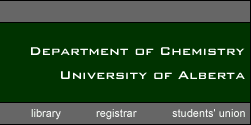


Chem 161 - Lecture Outline & Assignment #1
Readings:
TWG Solomons and CB Fryhle "Organic Chemistry" 8th Edition (2004):
- Functional Group List on pp 70-71 and (Periodic Table) one page back from Inside Back Cover
- Relative Strength of Acids and Bases on Inside Front Cover - same table on page 105 (most important now: HCl, H2O, CH3CH2OH, HCCH, CH2=CH2, CH3CH3 )
- Chapter 1 - Carbon Compounds and Chemical Bonds
- Chapter 2 - Representative Carbon Compounds, Functional Groups, Intermolecular Forces, Infrared (IR) Spectroscopy
- Chapter 3 - Acids and Bases - Mechanism and its representation
Problems:
Do Not turn in, answers available in "Study Guide and Solutions Manual for Organic Chemistry" by Solomons and Fryhle.
Chapter 1:
1.1 to 1.9; 1.11; 1.13 to 1.17; 1.21 to 1.23; 1.27; 1.31; 1.32Chapter 2:
2.1; 2.2; 2.3; 2.9; 2.17; 2.20; 2.21; 2.28; 2.32; 2.33; 2.35; 2.37; 2.39; 2.42Chapter 3:
3.1 to 3.3; 3.5; 3.7; 3.10; 3.11; 3.13; 3.15; 3.17; 3.20 to 3.22; 3.24; 3.27; 3.31; 3.36
Lecture Outline 1:
Nature of Chemical Bonds, Intermolecular & Intramolecular Forces
- Introduction - Course Organization, Nature of Science and Chemistry
- What is Science?
- What is Matter?
- Basic concepts and definitions - atoms, moles, etc
- What is Science?
- Physical Properties and Purity
- Purity
- Comparison of Physical Properties
- Methods of Purification
- Crystallization
- Distillation
- Extraction
- Chromatography
- Molecular Filtration – Dialysis
- Purity
- Analysis
- Qualitative - Organic or Inorganic
- Quantitative - Calculation of molecular and empirical formula
- Qualitative - Organic or Inorganic
- Atomic Structure
- Theory - wave functions and orbitals
- Periodic Table - Pauli principle, Hund rule, Aufbau
- Theory - wave functions and orbitals
- Molecular Structure
- Ionic bonding
- Covalent bonding
- Molecular orbitals - Linear Combination of Atomic Orbitals (LCAO)
- Hybridization and formation of sigma (s) and pi (p) bonds
- sp3
- sp2
- sp
- Size and Shape of Molecules
- Representation of Molecules
- Lewis Structures
- Formal Charge
- Resonance
- Ionic bonding
- Intermolecular Forces (Forces between different molecules)- van der Waals forces
- Electronegativity and Dipoles
- Dipole-Dipole Interaction
- London Forces
- Hydrogen Bonding
- Electronegativity and Dipoles
- Chemical Reactivity
- Bond Energy and Equilibrium
- Enthalpy
- Entropy
- Equilibrium
- Rate of Reaction and Activation Energy
- Acid-Base Reactions
- Lowry - Bronsted
- Acidity Constant and pKa
- Lewis acids and bases
- Bond Energy and Equilibrium